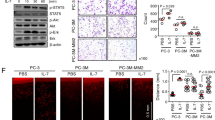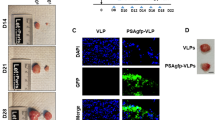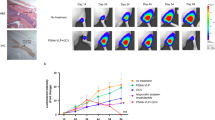Abstract
We had previously reported that REIC/Dkk-3, a member of the Dickkopf (Dkk) gene family, works as a tumor suppressor. In this study, we evaluated the therapeutic effects of an intratumoral injection with adenoviral vector encoding REIC/Dkk-3 gene (Ad-REIC) using an orthotopic mouse prostate cancer model of RM-9 cells. We also investigated the in vivo anti-metastatic effect and in vitro anti-invasion effect of Ad-REIC gene delivery. We demonstrated that the Ad-REIC treatment inhibited prostate cancer growth and lymph node metastasis, and prolonged mice survival in the model. These therapeutic responses were consistent with the intratumoral apoptosis induction and in vitro suppression of cell invasion/migration with reduced matrix metalloprotease-2 activity. We thus concluded that in situ Ad-REIC/Dkk-3 gene transfer may be a promising therapeutic intervention modality for the treatment of prostate cancer.
This is a preview of subscription content, access via your institution
Access options
Subscribe to this journal
Receive 12 print issues and online access
$259.00 per year
only $21.58 per issue
Buy this article
- Purchase on Springer Link
- Instant access to full article PDF
Prices may be subject to local taxes which are calculated during checkout





Similar content being viewed by others
References
Jemal A, Murray T, Ward E, Samuels A, Tiwari RC, Ghafoor A et al. Cancer statistics 2005. CA Cancer J Clin 2005; 55: 10–30.
Rittmaster RS, Thomas LN, Wright AS, Murray SK, Carlson K, Douglas RC et al. The utility of tissue transglutaminase as a marker of apoptosis during treatment and progression of prostate cancer. J Urol 1999; 162: 2165–2169.
Sehgal I, Baley PA, Thompson TC . Transforming growth factor beta1 stimulates contrasting responses in metastatic versus primary mouse prostate cancer-derived cell lines in vitro. Cancer Res 1996; 56: 3359–3365.
Ferreira CG, Epping M, Kruyt FA, Giaccone G . Apoptosis: target of cancer therapy. Clin Cancer Res 2002; 8: 2024–2034.
Curran S, Murray GI . Matrix metalloproteinases in tumour invasion and metastasis. J Pathol 1999; 189: 300–308.
Ren C, Li L, Goltsov AA, Timme TL, Tahir SA, Wang J et al. mRTVP-1, a novel p53 target gene with proapoptotic activities. Mol Cell Biol 2002; 22: 3345–3357.
Watanabe M, Nasu Y, Kashiwakura Y, Kusumi N, Tamayose K, Nagai A et al. Adeno-associated virus 2-mediated intratumoral prostate cancer gene therapy: long-term maspin expression efficiently suppresses tumor growth. Hum Gene Ther 2005; 16: 699–710.
Li H, Lindenmeyer F, Grenet C, Opolon P, Menashi S, Soria C et al. AdTIMP-2 inhibits tumor growth, angiogenesis, and metastasis, and prolongs survival in mice. Hum Gene Ther 2001; 12: 515–526.
Yang X, Wei LL, Tang C, Slack R, Mueller S, Lippman ME . Overexpression of KAI1 suppresses in vitro invasiveness and in vivo metastasis in breast cancer cells. Cancer Res 2001; 61: 5284–5288.
Krupnik VE, Sharp JD, Jiang C, Robison K, Chickering TW, Amaravadi L et al. Functional and structural diversity of the human Dickkopf gene family. Gene 1999; 238: 301–313.
Mao B, Wu W, Davidson G, Marhold J, Li M, Mechler BM et al. Kremen proteins are Dickkopf receptors that regulate Wnt/beta-catenin signalling. Nature 2002; 417: 664–667.
Hsieh SY, Hsieh PS, Chiu CT, Chen WY . Dickkopf-3/REIC functions as a suppressor gene of tumor growth. Oncogene 2004; 23: 9183–9189.
Abarzua F, Sakaguchi M, Takaishi M, Nasu Y, Kurose K, Ebara S et al. Adenovirus-mediated overexpression of REIC/Dkk-3 selectively induces apoptosis in human prostate cancer cells through activation of c-Jun-NH2-kinase. Cancer Res 2005; 65: 9617–9622.
Hoang BH, Kubo T, Healey JH, Yang R, Nathan SS, Kolb EA et al. Dickkopf 3 inhibits invasion and motility of Saos-2 osteosarcoma cells by modulating the Wnt-beta-catenin pathway. Cancer Res 2004; 64: 2734–2739.
Kuphal S, Lodermeyer S, Bataille F, Schuierer M, Hoang BH, Bosserhoff AK . Expression of Dickkopf genes is strongly reduced in malignant melanoma. Oncogene 2006; 25: 5027–5036.
Tsuji T, Miyazaki M, Sakaguchi M, Inoue Y, Namba M . A REIC gene shows down-regulation in human immortalized cells and human tumor-derived cell lines. Biochem Biophys Res Commun 2000; 268: 20–24.
Tsuji T, Nozaki I, Miyazaki M, Sakaguchi M, Pu H, Hamazaki Y et al. Antiproliferative activity of REIC/Dkk-3 and its significant down-regulation in non-small-cell lung carcinomas. Biochem Biophys Res Commun 2001; 289: 257–263.
Kobayashi K, Ouchida M, Tsuji T, Hanafusa H, Miyazaki M, Namba M et al. Reduced expression of the REIC/Dkk-3 gene by promoter-hypermethylation in human tumor cells. Gene 2002; 282: 151–158.
Kurose K, Sakaguchi M, Nasu Y, Ebara S, Kaku H, Kariyama R et al. Decreased expression of REIC/Dkk-3 in human renal clear cell carcinoma. J Urol 2004; 171: 1314–1318.
Kawano Y, Kitaoka M, Hamada Y, Walker MM, Waxman J, Kypta RM . Regulation of prostate cell growth and morphogenesis by Dickkopf-3. Oncogene 2006; 25: 6528–6537.
Nasu Y, Timme TL, Yang G, Bangma CH, Li L, Ren C et al. Suppression of caveolin expression induces androgen sensitivity in metastatic androgen-insensitive mouse prostate cancer cells. Nat Med 1998; 4: 1062–1064.
Nasu Y, Bangma CH, Hull GW, Lee HM, Hu J, Wang J et al. Adenovirus-mediated interleukin-12 gene therapy for prostate cancer: suppression of orthotopic tumor growth and pre-established lung metastases in an orthotopic model. Gene Therapy 1999; 6: 338–349.
Nasu Y, Djavan B, Marberger M, Kumon H . Prostate cancer gene therapy: outcome of basic research and clinical trials. Tech Urol 1999; 5: 185–190.
Watanabe M, Kashiwakura Y, Kusumi N, Tamayose K, Nasu Y, Nagai A et al. Adeno-associated virus-mediated human IL-10 gene transfer suppresses the development of experimental autoimmune orchitis. Gene Therapy 2005; 12: 1126–1132.
Nasu Y, Kusaka N, Saika T, Tsushima T, Kumon H . Suicide gene therapy for urogenital cancer: current outcome and prospects. Mol Urol 2000; 4: 67–71.
Lu X, Park SH, Thompson TC, Lane DP . Ras-induced hyperplasia occurs with mutation of p53, but activated ras and myc together can induce carcinoma without p53 mutation. Cell 1992; 70: 153–161.
Kusaka N, Nasu Y, Arata R, Saika T, Tsushima T, Kraaij R et al. Transrectal ultrasound for monitoring murine orthotopic prostate tumor. Prostate 2001; 47: 118–124.
Lester BR, McCarthy JB . Tumor cell adhesion to the extracellular matrix and signal transduction mechanisms implicated in tumor cell motility, invasion and metastasis. Cancer Metastasis Rev 1992; 11: 31–44.
Albini A . Tumor and endothelial cell invasion of basement membranes. The matrigel chemoinvasion assay as a tool for dissecting molecular mechanisms. Pathol Oncol Res 1998; 4: 230–241.
Vayalil PK, Katiyar SK . Treatment of epigallocatechin-3-gallate inhibits matrix metalloproteinases-2 and -9 via inhibition of activation of mitogen-activated protein kinases, c-jun and NF-kappaB in human prostate carcinoma DU-145 cells. Prostate 2004; 59: 33–42.
John A, Tuszynski G . The role of matrix metalloproteinases in tumor angiogenesis and tumor metastasis. Pathol Oncol Res 2001; 7: 14–23.
Lokeshwar BL . MMP inhibition in prostate cancer. Ann NY Acad Sci 1999; 878: 271–289.
Park MJ, Lee JY, Kwak HJ, Park CM, Lee HC, Woo SH et al. Arsenic trioxide (As2O3) inhibits invasion of HT1080 human fibrosarcoma cells: role of nuclear factor-kappaB and reactive oxygen species. J Cell Biochem 2005; 95: 955–969.
Ke Z, Lin H, Fan Z, Cai TQ, Kaplan RA, Ma C et al. MMP-2 mediates ethanol-induced invasion of mammary epithelial cells over-expressing ErbB2. Int J Cancer 2006; 119: 8–16.
Mitra SK, Hanson DA, Schlaepfer DD . Focal adhesion kinase: in command and control of cell motility. Nat Rev Mol Cell Biol 2005; 6: 56–68.
Hu B, Jarzynka MJ, Guo P, Imanishi Y, Schlaepfer DD, Cheng SY . Angiopoietin 2 induces glioma cell invasion by stimulating matrix metalloprotease 2 expression through the alphavbeta1 integrin and focal adhesion kinase signaling pathway. Cancer Res 2006; 66: 775–783.
Pukrop T, Klemm F, Hagemann T, Gradl D, Schulz M, Siemes S et al. Wnt 5a signaling is critical for macrophage-induced invasion of breast cancer cell lines. Proc Natl Acad Sci USA 2006; 103: 5454–5459.
Pollheimer J, Loregger T, Sonderegger S, Saleh L, Bauer S, Bilban M et al. Activation of the canonical wingless/T-cell factor signaling pathway promotes invasive differentiation of human trophoblast. Am J Pathol 2006; 168: 1134–1147.
Zorn AM . Wnt signalling: antagonistic Dickkopfs. Curr Biol 2001; 1: R592–595.
Caricasole A, Ferraro T, Iacovelli L, Barletta E, Caruso A, Melchiorri D et al. Functional characterization of WNT7A signaling in PC12 cells: interaction with A FZD5 x LRP6 receptor complex and modulation by Dickkopf proteins. J Biol Chem 2003; 278: 37024–37031.
Acknowledgements
This work was supported by a Scientific Research Grant from the Japan Society for the Promotion of Science (B(2) 15390491; Y Nasu) and a Health and Labor Sciences Research Grant from the Ministry of Health, Labor and Welfare (Third Term Comprehensive Control Research for Cancer; H Kumon). We thank Genofunction, Co. Ltd for providing an adenovirus vector carrying REIC/Dkk-3, and Yuka Matono and Katsuo Ohno for their technical assistance.
Author information
Authors and Affiliations
Corresponding author
Rights and permissions
About this article
Cite this article
Edamura, K., Nasu, Y., Takaishi, M. et al. Adenovirus-mediated REIC/Dkk-3 gene transfer inhibits tumor growth and metastasis in an orthotopic prostate cancer model. Cancer Gene Ther 14, 765–772 (2007). https://doi.org/10.1038/sj.cgt.7701071
Received:
Revised:
Accepted:
Published:
Issue Date:
DOI: https://doi.org/10.1038/sj.cgt.7701071
Keywords
This article is cited by
-
Novel extracellular role of REIC/Dkk-3 protein in PD-L1 regulation in cancer cells
Journal of Molecular Medicine (2023)
-
Adenovirus vector carrying REIC/DKK-3 gene: neoadjuvant intraprostatic injection for high-risk localized prostate cancer undergoing radical prostatectomy
Cancer Gene Therapy (2016)
-
The induction of antigen-specific CTL by in situ Ad-REIC gene therapy
Gene Therapy (2016)
-
Integrin antagonist augments the therapeutic effect of adenovirus-mediated REIC/Dkk-3 gene therapy for malignant glioma
Gene Therapy (2015)
-
NKD2, a negative regulator of Wnt signaling, suppresses tumor growth and metastasis in osteosarcoma
Oncogene (2015)



